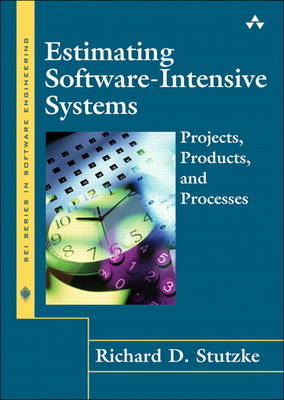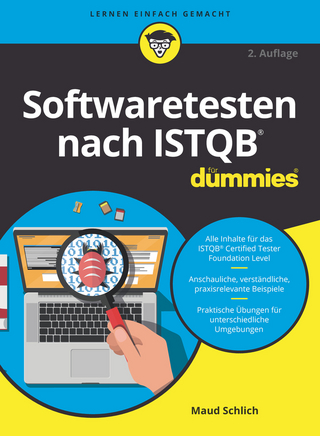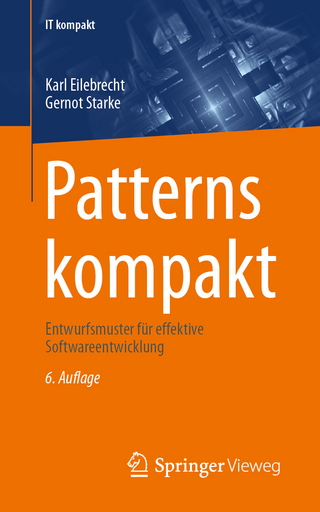
Estimating Software-Intensive Systems
Addison-Wesley Educational Publishers Inc (Verlag)
978-0-321-90492-8 (ISBN)
- Titel ist leider vergriffen;
keine Neuauflage - Artikel merken
Dick Stutzke presents here a disciplined and repeatable process that can produce accurate and complete
estimates for any project, product, or process, no matter how new or unusual. Stutzke doesn't just describe formal techniques: He offers simple, easy-to-use templates, spreadsheets, and tools you can start using today to identify and estimate product size, performance, and quality—as well as project cost, schedule, and risk reserves.
Stutzke shows how to quickly "get your arms around" users' problems and requirements, the structure of a solution, and the process needed to deliver it. You'll learn how to choose the most appropriate estimating techniques and tools; collect accurate data, track progress, and update estimates; and recalibrate estimating models to improve estimation accuracy.
Stutzke's techniques apply whether you're creating custom in-house business software, purchasing or customizing "off-the-shelf" technology, or constructing complex, one-of-a-kind military, industrial, or commercial systems. These techniques apply to small and large projects, and to all project life cycles—from agile to plan-driven. This book will help you plan, estimate, budget, schedule, purchase, design, build, test, deploy, operate, and maintain software-intensive systems. It explains how to size software, identify all cost components, calculate the associated costs, and set a competitive price.
A separate section covers topics of interest for large projects: designing an appropriate work breakdown structure, collecting data from cost accounting systems, and using earned value measurement.
Dr. Richard D. Stutzke has more than 40 years experience with software development and project management in the military and industry, including scientific, embedded real time, and commercial systems. He has authored more than fifty papers and articles on software estimation and management. In 1989, he established Science Applications International Corporation's Corporate Software Process Group and led it for two years. Since then, he has focused on defining integrated processes for developing software-intensive systems and managing their development and operation. © Copyright Pearson Education. All rights reserved.
Preface.
Acknowledgments.
About the Author.
I. The Essentials.
1. Introduction.
Reasons to Estimate and Measure.
Specific Quantities to Estimate and Measure.
The Nature of Estimation.
Unprecedented Systems.
Why Software Is Especially Hard to Estimate.
A Practical Approach.
Recommended Reading.
Summary.
2. Planning a Warehouse Inventory System.
Warehouse Inventory Management System.
Recording the Information.
Discussion of the Example.
Doing Better: A Planning Workbook.
Recommended Reading.
Summary.
3. A Basic Estimating Process: The Linear Method.
Criteria for “Good” Estimates.
Types of Resources.
Proxy-Based Estimation.
The Linear Method: A Simple Process.
Using the Linear Method.
Documenting Your Estimates.
Standard Forms.
Managing Your Information.
Recommended Reading.
Summary.
4. Measurement and Estimation.
Reasons to Measure.
Measuring Size and Productivity (Direct and Indirect Measures).
Criteria for “Good” Measures.
Operational Definitions.
Choosing Useful Measures.
Recommended Reading.
Summary.
5. Estimating Techniques.
Expert Judgment: The Delphi Technique.
Additive and Multiplicative Analogies.
Program Evaluation and Review Technique (PERT).
An Example: Using PERT Values.
Using the PERT Values to Estimate Risk Reserve.
Algorithmic Analogy Estimation.
Recommended Reading.
Summary.
6. Estimating Annual Maintenance Costs.
The Maintenance Process.
Building the Estimation Model.
Calibrating the Model.
Tracking and Updating.
Improving the Estimation Model.
Recommended Reading.
Summary.
II. THE DETAILS.
7. Preparing to Estimate (Precursors of Estimation).
The Precursors of Estimation.
How to Understand the Overall Job: The Key Diagrams.
The Operational Concept.
Identifying Products and Services.
Product Requirements.
Product Architecture.
Project Goals and Constraints.
Recommended Reading.
Summary.
8. Estimating Software Size: The Basics.
The Sizing Process.
Example: Using the Operational Concept.
Sizing Hardware.
Accounting for Size Growth and Volatility.
Tracking Size.
Implementation Guidance.
Recommended Reading.
Summary.
9. Estimating Software Size: The Details.
Requirements.
UML-Based Sizing and Use Case Points.
Application Points.
Web Objects and Internet Points.
Function Points.
Simplified Ways to Count Function Points.
Object-Oriented Size Measures.
Defining Source Lines of Code (SLOC).
Estimating New Code.
Sizing Reused Source Code.
“Sizing” Commercial Off-the-Shelf Software Components.
The COCOTS Model.
Recommended Reading.
Summary.
10. Production Processes (Project Life Cycles).
Elements of a Project Life Cycle Model.
The Spectrum of Software Life Cycles.
Choosing an Appropriate Project Life Cycle.
Extending the Basic Development Life Cycle Models.
Production and Delivery Activities.
Recommended Reading.
Summary.
11. Bottom-Up Estimating and Scheduling.
Summary of the Process.
The Work Breakdown Structure.
Creating Your WBS.
Scheduling.
Building the Network: Cards on the Wall Method.
Recommended Reading.
Summary.
12. Top-Down Estimating and Allocation.
Relating Effort, Duration, and Staffing.
Planned Versus Actual Availability.
Schedule Compression.
Allocating Effort and Time.
Some Examples.
Recommended Reading.
Summary.
13. Parametric Models.
Types of Parametric Models.
Core Effort and Schedule.
A Simple Parametric Model.
Adding Missing Phases and Activities.
Adjusting for Different Characteristics.
Handling Size, Cost, and Schedule Constraints.
Evaluating a Hardware/Software Trade.
Calibrating Parametric Models.
Parametric Models for Hardware Costs.
Selecting an Automated Estimation Tool.
Helping Nonestimators Provide Good Parameter Values.
Recommended Reading.
Summary.
14. Estimating Risk Reserves.
Concepts.
The Risk Management Process.
Identifying Risks and Mitigation Actions.
Analyzing and Prioritizing Risks: Risk Impact.
Calculating the Risk Reserve.
Planning: Deciding to Defer Mitigation Tasks.
Tracking and Updating.
Other Approaches.
Recommended Reading.
Summary.
15. Calculating Cost and Price: The Basics.
Direct and Indirect Costs.
Calculating Direct Costs.
Calculating Indirect Costs.
Profit and the “Fee Rate”.
Calculating the Loaded Cost.
Management Reserves.
Cash Flow and Interest Costs.
Opportunity Cost.
Determining the Selling Price for a Product6.
Evaluating the Total Ownership Cost.
Evaluating a Product or Project.
Reducing the Cost or Price.
The Need for Multiple Models.
Recommended Reading.
Summary.
III. CLOSING THE FEEDBACK LOOP.
16. Collecting Data: Basics.
Why Should You Even Collect Historical Data?
Collecting Data.
Data Collection Templates.
Automating Data Collection and Analysis.
Collecting Effort and Cost Data.
Recommended Reading.
Summary.
17. Tracking Status.
Assessing Status.
Tracking Test Status.
Tracking Size and Productivity.
Tracking Size with Error Bars.
Trendlines.
Regression Fitting.
Other Ways to Detect Trouble.
Recommended Reading.
Summary.
18. Updating Estimates.
Reasons to Update Estimates.
The Basic Process.
When to Prepare Updated Estimates.
Preparing Updated Estimates.
Preparing an Estimate to Complete.
Recommended Reading.
Summary.
19. Consolidating and Applying Your Knowledge.
Review of Estimation and Measurement.
Implementing Estimation and Measurement.
Defining an Estimation Process.
Establishing an Integrated Estimation Process.
Useful Resources.
Addressing New Technologies and Processes.
Recommended Reading.
Summary.
IV. HANDLING LARGE PROJECTS.
20. Crafting a WBS.
The Work Breakdown Structure: Additional Concepts.
A Generic WBS (HW, SW, Data, Services).
Examples of Alternate Partitioning.
Customizing Your WBS.
Recommended Reading.
Summary.
21. Earned Value Measurement.
Concepts.
Assessing Overall Project Status.
Converting Schedule Variance to Time.
Interim Milestones.
Earned Value Example.
Prediction Completion Costs.
Recommended Reading.
Summary.
22. Collecting Data: Details.
Project Tracking Systems.
Time Reporting and Cost Accounting Systems.
Defining “Good” Charge Numbers.
Limitations of Accounting Systems.
Activity-Based Costing.
Tracking Heterogeneous Project Teams.
Tracking IDIQ Contracts.
Recommended Reading.
Summary.
23. Calculating Costs and Bid Price.
Review of Direct and Indirect Costs.
Rate Types for U.S. Government Contracts.
Financial Risks of U.S. Government Contracts.
Calculating a Bid Price.
Management Reserves.
Cash Flow and Interest Costs.
Setting a Bid Price.
Reducing the Price.
Recommended Reading.
Summary.
V. ESTIMATING PRODUCTS AND PROCESSES.
24. Determining Product Performance.
Types of Product Performance.
Estimating and Measuring Software Performance.
Performance Measurement.
Rough Order of Magnitude Calculations.
The Resource Usage Matrix.
Modeling Web-Based Systems.
Queueing Models.
Simulation.
Choosing a Technique.
Performance Engineering Process.
Estimating Costs for Performance Engineering.
Recommended Reading.
Summary.
25. Determining Product Quality.
Why Product Quality Is Important.
Defining Quality.
Determining Quality During a Project.
Estimating Defects During Design and Construction.
RADC Model.
COQUALMO.
Measuring Defects During Testing.
Estimating Software Reliability.
Error Trending.
Measuring Defects Using Capture/Recapture.
Observing Defects During Actual Use.
Closing the Loop.
Internal Measures of Software Quality.
Measures of Document Quality.
Recommended Reading.
Summary.
26. Measuring and Estimating Process Performance.
Defining a Process.
Controlling Production Processes.
Measuring Process Performance.
Measuring the Cost of Quality.
Predicting Process Performance.
Statistical Process Control.
Staged Defect Removal Models.
Dynamic Models.
Building Process Performance Models.
Recommended Reading.
Summary.
27. Ranking and Selecting Items.
Introduction.
Voting Techniques.
A Technique to Handle Two Criteria.
Techniques to Handle Multiple Criteria.
Multi-Attribute Utility Theory (MAUT).
The Analytic Hierarchy Process.
Estimating Module Size Using AHP.
Recommended Reading.
Summary.
Appendix A: Roles and Responsibilities for Estimation.
Appendix B: Measurement Theory and Statistics.
Measurement and Scale Types.
Statistics and Scale Types.
Statistical Measures.
Recommended Reading.
Appendix C: Measures of Estimation Accuracy.
Statistics of a Set of Estimates.
Statistics of a Time Sequence of Estimates.
Choosing the “Best” Measure of Estimation Accuracy.
Using Excel to Calculate Estimation Error.
Appendix D: Summation Formulas for Series.
Appendix E: Excel for Estimators.
Introduction.
Basic Concepts.
Labeling Spreadsheets and Documents.
Helping Users.
Printing.
Plotting (“Charting”).
Advanced Features.
Macros and Visual Basic for Applications.
Acronyms.
Glossary.
Introduction.
Terms.
Bibliography.
Index.
| Erscheint lt. Verlag | 15.1.2013 |
|---|---|
| Verlagsort | New Jersey |
| Sprache | englisch |
| Maße | 160 x 230 mm |
| Gewicht | 1350 g |
| Themenwelt | Mathematik / Informatik ► Informatik ► Software Entwicklung |
| Technik ► Nachrichtentechnik | |
| ISBN-10 | 0-321-90492-3 / 0321904923 |
| ISBN-13 | 978-0-321-90492-8 / 9780321904928 |
| Zustand | Neuware |
| Haben Sie eine Frage zum Produkt? |
aus dem Bereich


